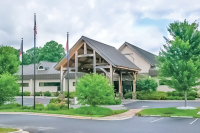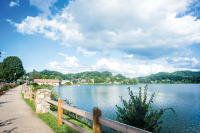Trees up close and personal
Winter is a great time for studying tree identification. The mountains look steel-gray from a distance. The forest, up close, is a study in muted earth tones. There’s bark, smooth grey bark, scaly, nearly black bark, fissured gray bark and papery yellow bark to name a few. There are terminal buds, auxiliary buds and lateral buds. Twigs may be hairy (pubescent) or smooth (glabrous). By learning these characters and characteristics, you can turn a winter forest of cold gray and brown timbers into a living forest of black cherry, red maple, basswood, mockernut hickory, Southern red oak, Northern red oak, etc.
Most plant identification manuals like the Manual of the Vascular Flora of the Carolinas depend almost wholly on flower and leaf characteristics to identify species. Most field guides are similarly dependant upon flowers and leaves. There are a few guides out there that address winter trees. Winter Tree Finder by May and Tom Watts and Peterson’s A Field Guide to Eastern Trees are two that I’ve heard good things about. And there is a great one, Woody Plants of the Southeastern United States A Winter Guide, by Western North Carolinian Ron Lance.
Lance, a Hendersonville native and graduate of Haywood Community College, is currently the park naturalist and nursery curator at Chimney Rock State Park. Lance received a degree from HCC’s wildlife program in 1975 and from its lumber specialist program in 1984. Since that time Lance has had a long and varied career working with woody plants as an educator, taxonomist, curator and researcher.
Lance taught at HCC for eight years after graduating and spent 13 years at the North Carolina Arboretum, where he helped create an outstanding collection of trees and shrubs including many rare species. His work with hawthorns led to the rediscovery of Crataegus harbisonii and a book titled Hawthorns and Medlars.
I became acquainted with Lance’s field guide work when HCC professor Rick Lindsay gave me a copy of “Woody Plants of the Blue Ridge”, a spiral-bound guide used by students at HCC. I found the guide direct and easy to use.
Woody Plants of the Southeastern United States is a much more extensive and expansive treatise covering more than 800 species including naturalized exotics that grow across the diverse habitats of the Southeastern U.S. from southern Delaware west to Kansas and south to Texas and northern Florida. Because of its scope, it requires larger, more detailed keys, but I still find the keys direct and user-friendly. The keys are Lance’s own. As he mentions in the introduction, “...I developed the style and content of the keys and illustrations within the book in my own instructional courses and independent study over a span of eighteen years.”
Related Items
I believe Lance’s extensive field experience, especially with students of all levels has given him the eye and the intuition to create an extensive guide that is accessible to amateur tree sleuths like myself.
There is no escaping the need for precise botanical terms in the keys, but the book’s introduction with its illustrations and the glossary make those terms much less intimidating.
The book comes with a couple of note cards labeled “ERRATA” pointing out errors in the key on page 31 and errors in illustrations on page 240. In my copy, I took a razor-tipped pen and changed the key on page 31 and I clipped and pasted the correct illustrations over the ones on page 240.
If you enjoy learning about woody plants, winter provides an excellent opportunity. No matter what guide you use, the time you spend learning to identify trees in the winter will immeasurably aid your identification skills. You will learn bark and twig characteristics that you can call upon any time of year. Plus you will learn more about that intangible “jizz” – that essence that defines different species and speaks to your intuition.









